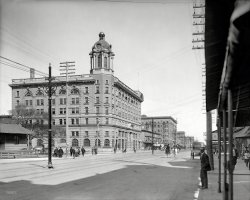
MAY CONTAIN NUTS

Search Shorpy
SHORPY ART

Framed or unframed, desk size to sofa size, printed by us in Arizona and Alabama since 2007. Explore now.
Join and Share
Ad-Free Shorpy
Shorpy is funded by you. Patreon contributors get an ad-free experience.
Learn more.

Recent comments
- Baldwin 62303
- Baldwin VO-1000
- Cold
- No expense spared
- Tough Guys
- Lost in Toyland
- And without gloves
- If I were a blindfolded time traveler
- Smoke Consumer Also Cooks
- Oh that stove!
- Possibly still there?
- What?!?
- $100 Reward
- Freeze Frame
- Texas Flyer wanted
- Just a Year Too Soon
- WWII -- Replacing men with women at the railroad crossing.
- Yes, Icing
- You kids drive me nuts!
- NOT An Easy Job
- I wonder
- Just add window boxes
- Icing Platform?
- Indiana Harbor Belt abides
- Freezing haze
- Corrections (for those who care)
- C&NW at Nelson
- Fallen Flags
- A dangerous job made worse
- Water Stop
Member Photos
The Shorpy
Print Emporium
Print Emporium
Search Shorpy
Search results -- 30 results per page
- The Whiteboard Jungle: 1957
- ... MIT as early as the late 1800s. Historian Ross Bassett of North Carolina State University has been documenting the history of Indian engineers ... Posted by Dave - 11/03/2013 - 12:41pm -
![The Whiteboard Jungle: 1957 Circa 1957. "IBM Manufacturing and Administrative Center, Rochester, Minnesota. Cafeteria. Eero Saarinen, architect." Medium format negative by Balthazar Korab. View full size.
Fire ExtinguishersApparently, only tall people are supposed to fight fires.
Where's Waldo?All white males.
[Except for the women. -tterrace]
A sea of white shirtsMy uncle worked for IBM in the early 60's in NYC. He had a wardrobe full of white shirts as that was all they were permitted to wear if they dealt with the public. I'm thinking the striped shirt and plaid shirt guys were visitors or only worked internally?
Industrial ModFirst of all, I don't see anything that would burn in that cold, anuglar room. It's about as unwelcoming as a place could be what with its "I" beams everywhere, bland light fixtures and the plants, if they are real, don't even provide any relief. A perfect set right out of "The Organization Man" or "The Man in the Gray Flannel Suit" and I'm sure Atlas would have shrugged in this year of his birth.
Smoke 'em if you got em.Ashtrays on every table, fire extinguisher on every pole.
37 years an IBM-erMy dad was a field engineer for IBM from 1952 to 1987. Into the 1970s, he would come home from work with grease on his white shirts from fixing computers and printers. I got to play "office lady" with discarded punch cards, and he still has a box of old paper from a daisy-wheel printer that he doesn't want to throw away!
Sign of the timesThat picture reminds me so much of my high school cafeteria, which was built in 1956-57. If that building is still standing, I wonder how many of those windows remain. Most other buildings I've seen have replaced most of their windows with solid walls.
CuttingsThe ubiquitous cut-leaf philodendron of the 1950s and early 1960s are rarely seen in homes or businesses. Then it was the most popular indoor plant. It was very attractive, practically kill-proof, didn't leave dead leaves all over and was relatively easy to trim or let go wild, depending on your taste. We had one from about 1958 until the mid-1970s that survived three moves and a fair bit if neglect and/or overwatering. It finally died after one of our cats took to "watering" it himself.
Parsi engineersIt is likely that there are several men of colour in the photo.
There were many Indian, especially Parsi, electrical and computer engineers working at IBM and other major companies. Students from India were studying engineering and in other technical fields at MIT as early as the late 1800s. Historian Ross Bassett of North Carolina State University has been documenting the history of Indian engineers who studied at MIT and the Indian Institute of Technology and who became engineers at IBM and other companies.
He is working on a bio of my step-father, Soli Dubash, (amongst others) who studied engineering at MIT before and after WWII and went on to work on many prominent architectural projects across Canada, achieving the position of Chief Engineer at the Department of Public Works, here in Ottawa.
http://history.ncsu.edu/faculty/view/ross_bassett
http://www.youtube.com/watch?v=Qht2ReRubP0&list=PL7F39BE4A3867E47F&index...
I've been working here for thirty yearsIn answer to previous comments...
The floor to ceiling windows in this photo were just replaced this summer (2014) with a new set of energy efficient windows. Still floor to ceiling.
Fire extinguishers are gone. "Best practice" now in case of fire is to exit the building and leaving the fire fighting to the pros.
Ashtrays are gone. The site has been smoke free for many years now. People still dumb enough to smoke have to stand out by the parking lot in the 20-degree below zero winters.
Mentioned in the photo caption, Eero Saarinen is now considered one of the masters of mid-20th century American architecture. He designed campuses for several large corporations. His most famous work was probably the "Gateway Arch" in St. Louis.
The IBM campus in Rochester, MN shown here is a grid of many low buildings (at most two stories above ground level). It was IBM's first US facility built outside of the Northeast US. With more square footage than the Empire State Building and roughly half the size of the Pentagon, this facility has, for decades, been IBM's largest facility under one roof.
(The Gallery, Balthazar Korab, Eateries & Bars, The Office)](https://www.shorpy.com/files/images/SHORPY_00522u.thumbnail.jpg)
- The Thin Manse: 1936
- 1936. Edgecombe County, North Carolina. "J.F. Dozier Farm, Tarboro vicinity." 8x10 inch acetate negative by ... Posted by Dave - 07/22/2012 - 4:44pm -
![The Thin Manse: 1936 1936. Edgecombe County, North Carolina. "J.F. Dozier Farm, Tarboro vicinity." 8x10 inch acetate negative by Frances Benjamin Johnston. View full size.
The Thin ManseGreat play on words Dave. You've outdone yourself.
Yes it isa bit tweaked, squeezed and peaked!
Odd columnsI wonder why they thought lack of symmetry in the spacing of the porch columns was a good thing, design-wise?
[The columns line up with the door, which is off-center. - Dave]
Preserved!This is the Wilkinson-Dozier House (c. 1825). It has been beautifully preserved. More photos.
Wilkinson-Dozier HouseBuilt by Joshua Wilkinson between 1816 and 1826. This Federal style home with a double tiered portico was put on the National Register of Historic Places in 1974.
Earl RobersonMy cousin Earl, who died recently, was the owner of this house. Here is a picture of him (seated) at my family reunion a few years ago. His house is across a few fields from mine. More photos.
Le Mince Manse, en couleurThe Twilight World of Shorpyville version.
(The Gallery, F.B. Johnston)](https://www.shorpy.com/files/images/02556a.thumbnail.jpg)
- Grill Noir: 1940
- May 1940. "A hamburger shop in Durham, North Carolina." George's Grill, open all night. 35mm nitrate negative by Jack ... Posted by Dave - 08/05/2014 - 9:35am -
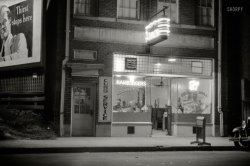
- Hearth to Hearth: 1935
- Ca. 1935-1938. Nash County, North Carolina. "Tories Tavern, Nashville vicinity. Structure dates to 1766." Photo ... Posted by Dave - 08/30/2012 - 11:06am -
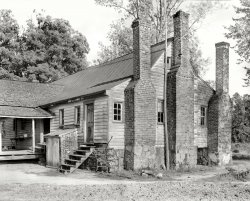
- Me and My Shad: 1920
- ... Old Hotel."
Joseph Mitchell was from a small town in North Carolina; after graduating from college, he moved to New York, where he ... Posted by Dave - 09/13/2011 - 1:33pm -
![Me and My Shad: 1920 Circa 1920. "Shad fishing on the Potomac." National Photo Co. View full size.
"Gluttonous Springtime Blowouts"Here's a quote about shad bakes from catfish1.com
During the shad's Hudson River heyday, virtually every river town could boast at least one big annual shad bake—the Hudson's equivalent of the New England shore dinner. New Yorker essayist Joseph Mitchell, in his 1959 piece "The Rivermen," calls these bakes "gluttonous springtime blowouts" and remembered when huge bakes were given by churches, lodges, labor unions, and local politicians.
"The Rivermen" was a long essay for the New Yorker. It was later collected in Mitchell's "The Bottom of the Harbor," which itself was later collected in the masterpiece "Up in the Old Hotel."
Joseph Mitchell was from a small town in North Carolina; after graduating from college, he moved to New York, where he reported for several newspapers and eventually began writing for the The New Yorker in 1933. He worked there until his death in 1991, although he effectively stopped writing in 1964. Shorpyites who are fascinated by the old urban photos, especially of New York City, would likely be fascinated by Mitchell's writing.
Bad shadI've always thought of shad as a trash fish. Were they considered more desirable in 1920 or is there something I don't know about them?
[Planked shad was practically a religion in this part of the country. And shad roe is considered a delicacy by many. - Dave]
Blind to their Own InterestsShad were once plentiful in the Potomac, Delaware and Hudson rivers. Overfishing and pollution were greatly reducing their numbers at the time of this photo. Due to efforts to stock the river with fry and roe, the population in the Potomac lasted a few years longer then those in the Delaware and Hudson. There is now an ongoing project to restore shad to the river.
On a culinary note, in addition to planked shad for dinner, newspapers of the time mention bacon-garnished shad roe as a popular breakfast treat. Of course making a delicacy of the thousands of eggs in each fish no doubt hastened their decline.
Additionally, please don't interpret the title of this post (Blind to their Own Interests, extracted from one of the following newspaper articles) as a condemnation of the hard-working fishermen of the time. Overfishing, as in many exploitations of shared resources, is due to the larger dilemma of the Tragedy of the Commons.
Washington Post, Dec 20, 1915
Driving Out Potomac Shad
Fish Will be Gone Says Commission,
if Greedy Catch Isn't Stopped
Unless protective measures are taken at once by the State of Maryland and Virginia there is a danger that the shad, the most valuable of the migratory river fishes of the Atlantic seaboard, will become unknown in Chesapeake Bay and the Potomac River.
A real note of alarm in this respect was sounded in the annual report of the government bureau of fisheries, which was issued yesterday. Not only is it indicated that the fisheries laws of Maryland and Virginia should be amended, but the laws of all the Atlantic coast States as well.
"The bureau repeatedly has pointed out the shortsighted and destructive course pursued by some of the States with reference to this most important fish," the report said. "The most serious condition exists in the Chesapeake basin, where in 1915, the fishing was the poorest ever known, following a season that was the poorest in a generation. No limits are placed on the operations of the fishermen, who seem blind to their own interests. Every stream which the shad can try to ascend is literally choked with nets.
Washington Post, Nov 27, 1925
Fish Disappearing
Commissioner O'Malley, of the Bureau of Fisheries declares in his annual report that the country is at last awakening to the need of conservation if serious depletion of some of the most important American fisheries is to be checked. ...
A few years ago shad visited the waters of the Potomac in sufficient numbers to enable the proprietors of the resorts along the shores between Washington and Indian Head to offer a round trip ticket on their steamers with a "whole planked shad and a moonlight ride on the return," all for a dollar. In those happy days fishermen offered the choicest "roe shad " at the height of the season for "a levy," and itinerant peddler would bring one to your door, all dressed, for a quarter. Frequently when the fish were "runnin' strong" they were a drug on the market, to be had for carrying them away. Farmers along both shores of the river salted hundreds of barrels of shad and herring every spring, while "Potomac Robins," as the herring were known, were the staple food of most of the colored laboring class.
1914 Advertisement
Washington Post, Jul 22, 1926
Will The Shad Come Back?
...
Thousands of citizens not yet out of the "thirties" can remember when the fish peddler cried his wares through the streets of Washington early in the spring when a roe-shad big enough for a family dinner could be purchased for a "quarter." But there has been a gradual falling off in the catch every year for more than a decade and last May, in the height of the season, the haughty fishmonger scorned the dollar proffered for an insignificant "buck."
The United States fish commissions has carried on restocking operations in the Potomac during the past nine or ten years. This season the number of fry turned into the river at the hatchery opposite Mount Vernon was the smallest in years. There were 10,000,000 fingerlings released from the hatchery. In some years the number has reached 80,000,000 and the commissioner is still hopeful that results will be shown in the returns from the seine haulers.
The falling off in the number of shad caught in Northern waters can only be explained by the growth of cities on the banks of the rivers and the erection of all sorts of manufacturing plants along the shores which have resulted in the pollution of the waters and killed off young fish by the millions. ...
Oh, waiterThe popularity of shad roe is illustrated in the Cole Porter song "Let's Do It" with the line "Why ask if shad do it? Waiter, bring me shad roe."
Fish storyShad fishing in the Hudson River remained a major seasonal activity until well into the 1950's: the rivermen would live on their boats/barges during the shad run. Some time earlier, large sturgeon were plentiful enough on the Lower Delaware that there was a town (Caviar) built around the harvesting of their roe. The Central Railroad of New Jersey had a freight line serving the town.
Not much left of that now.
ShadHere on the Tennessee river, shad are used for cut bait on trot lines. You have to cut up a shad and get the pieces on the hooks as they don't "keep very well" in warm weather.
(The Gallery, Boats & Bridges, D.C., Natl Photo)](https://www.shorpy.com/files/images/18293u.thumbnail.jpg)
- Bee Movie: 1939
- ... 1939. "The main street, Chatham Avenue, of Siler City, North Carolina." Photo by Dorothea Lange for the Farm Security Administration. View ... Posted by Dave - 08/22/2014 - 10:36pm -
![Bee Movie: 1939 July 1939. "The main street, Chatham Avenue, of Siler City, North Carolina." Photo by Dorothea Lange for the Farm Security Administration. View full size.
Domes v flatsThere are five domed covers over what appear to be utility hand holes (they're too small to be man holes)in the street. Today such covers are flat. Were domed covers common in 1939?
[In the days before lane striping was common, such metal domes were used to direct traffic at intersections. In my home town of Larkspur, California, two were still in place through the 1950s, until they were eventually paved over. -tterrace]
Belk'sIn the South, we have Belk Department Stores. I think I see one in this photo down on the left. Back when I was a kid, they were known colloquially as Belk's. The company also signed and marketed them that way. My family didn't shop there; too rich for our blood.
The Happy CarIn the center of the street is a 1939 Chrysler which, because of the dip in the center of the front bumper, looks like something that was meant to be in the movie "Cars."
The model name on the leading edge of the hood is too out of focus to read, but the car is likely to be a Royal or Royal Windsor which combined totaled 45,955 out of Chrysler's 67,749 cars produced that year. There were no Chrysler convertibles in 1939, but you could order a Saratoga or New Yorker with a sun roof. Only 239 cars were ordered with the option.
Human beings!Several old photos from Siler City show lots of folks walking or standing on the sidewalks, just passing the time of day with their neighbors.
In photos of the same places today, few if any people are visible on the sidewalks. Thus, the contemporary scenes seem sterile and uninviting.
The difference is not unique to Siler City, of course.
Chatham Ave. at E. RaleighGoogle Maps doesn't have a very clear view replicating this old photograph (that I can find), but it appears that the old photograph is a view looking North-north-west up Chatham Avenue across East Raleigh Street in Siler. The Chatham Bank on the corner is now gone, but the distinctive old building remaining is up Chatham Avenue on the right, a finial-topped little 'gothic' building surviving as the "Hotel Hadley"
Bank ShotThis is Chatham Avenue at Raleigh Street looking north. The Chatham Bank building is gone, but the buildings on the west side of the street have survived.
View Larger Map
(The Gallery, Cars, Trucks, Buses, Dorothea Lange, Small Towns)](https://www.shorpy.com/files/images/SHORPY-8b34138a.thumbnail.jpg)
- Melon Munchkins: 1939
- July 1939. Person County, North Carolina. "Millworker's house six miles north of Roxboro." Medium format negative by Dorothea Lange. View full size. ... Posted by Dave - 07/04/2018 - 1:07pm -
![Melon Munchkins: 1939 July 1939. Person County, North Carolina. "Millworker's house six miles north of Roxboro." Medium format negative by Dorothea Lange. View full size.
Re: Melon MemoriesMy grandmother would tell us similar stories, but she would first open a hole in the melon and fill it full of vodka. She was always the life of the party.
Toddler with a bladeWhat could possibly go wrong? Looks like big sister has one as well.
Melon MemoriesMy grandpa loved his watermelons. Big farm family with 14 kids. In late summer for Sunday dinner he would take two or three and lower them down into a really cold well. [They'd been bad? - Dave] Then a couple hours after food, up would come the home-grown melons. What I would give to go back.
A treat is a treatAnd when you're a kid with very little, just the tiniest bit more can make you happy.
Meanwhile, the hounds aren't worried around this homestead -- that porch foundation looks sturdy enough.
MannersIn my family it was considered the height of rudeness to eat just the heart of the melon and skip the chore of having to spit seeds.
A real log cabinMy father amassed quite a lot of information about old log cabins in the Midwest. When he passed, he bequeathed the entire collection to a local university. He would think nothing of driving down a dirt road for a ways and talk to the old timer sitting on his parch holding a shotgun. He would bring along bits of his collection to show his interest was in the log cabin about half a mile away. Most of the time people were glad to offer any information they had, with only a few telling him to skedaddle.
He told me that later on, a lot of people would cover the outside with sheathing and some even used vinyl siding. He said one way to tell if the structure is a log cabin is to look at how far the windows are spaced from the corners. Also, they used horsehair to jam in between the logs to keep the draft down.
Real log cabinsMy dad's family home in Kentucky was originally a log cabin (late 18th century), which was incorporated into the final big house. The walls of the entry parlor, all that's left, are something like 18 inches thick.
(The Gallery, Dorothea Lange, Kids, Rural America)](https://www.shorpy.com/files/images/SHORPY-8b34177a.thumbnail.jpg)
- Piano Man: 1938
- ... is the divine mover.
Patrick Frye III
Charlotte, North Carolina
Rice Festival Its now the International Rice Festival. Info ... Posted by Dave - 04/16/2008 - 9:14pm -
![Piano Man: 1938 October 1938. "Pianist in cajun band contest. National Rice Festival, Crowley, Louisiana." View full size. Medium format negative by Russell Lee for the FSA.
Rather EnviousHe had beautiful eyelashes. A wonderful expression of calm concentration.
Hair ...As long as I've had wavy hair, I never got it to look like that.
Wow, he's got the Jerry LeeWow, he's got the Jerry Lee Lewis wavy hair--or VV!
Rice FestivalWhat was the National Rice Festival?
New keys, pleaseThe piano looks as though it has seen better days. The action on the depressed B needs work. Also, the G needs an ivory replacement. I can only imagine how this roughed up instrument sounded!
Rather Envious//Music and MeaningThis expression IS what one has when you know what power music has and how that power affects others. The performer is no longer the master--it is the music itself that is the divine mover.
Patrick Frye III
Charlotte, North Carolina
Rice FestivalIts now the International Rice Festival. Info here:
http://www.ricefestival.com/
Jerry Lee If this isn't Jerry Lee Lewis, it's his doppelganger.
[In October 1938, Jerry Lee Lewis was 3 years old. - Dave]
(The Gallery, Music, Russell Lee)](https://www.shorpy.com/files/images/8b20509u.thumbnail.jpg)
- Simon Birdsong: 1914
- November 1914. Roanoke Rapids, North Carolina. Rosemary Manufacturing Co. Two violations. Simon Birdsong, left hand ... Posted by Dave - 05/07/2008 - 10:40pm -
![Simon Birdsong: 1914 November 1914. Roanoke Rapids, North Carolina. Rosemary Manufacturing Co. Two violations. Simon Birdsong, left hand boy. "I'm about 12." His mother said: "He's old enough to work all right," but the boy admitted that she had to sign up that he was older than he was. He appears to be 10. Has had job doffing for several weeks. Could not write his own name. Has had no schooling after the 1st grade. Wylie Haw (right hand boy). Mother says he is 12 years old now. Been working 1 year. She is a widow. Photo and caption by Lewis Wickes Hine. View full size.
Simon BirdsongThis is Joe Manning, of the Lewis Hine Project. This search sure didn't take long. I talked to Simon's daughter today. She didn't know about the photo. I will be interviewing her shortly. From what she's already told me, it looks like quite an amazing story.
[Thankyou thankyou. Keep us posted. - Dave]
Simon BirdsongAny updates on Simon's daughter?
Re: Simon BirdsongThis is Joe Manning. I interviewed Simon's daughter, but I am not ready to publish the results as yet. It's a very interesting story.
Simon Birdsong: 1914This is Joe Manning, of the Lewis Hine Project. I have posted my story about Simon, including the interview with his daughter, and photos of Simon as an adult.
www.morningsonmaplestreet.com/simonbirdsong1.html
So Much for StatisticsAccording to life-expectancy tables, Simon should not have lived beyond 50-55 years. He not only lived a full and very interesting life, he certainly lived a long one (90 years) in spite of starting work at such a young age. This, too, puts beliefs in the destructive nature of child labor in another light.
To Joe Manning: Your research makes everything come alive and for that I thank you.
What a Great StoryThank you Joe (and Dave) for Simon's daughter's story. Her dad was surely a singular man and indeed fortunate that he had the grit and gumption to get out of the mills.
During the early 80's, I had to go to Roanoke Rapids nearly every month for my job with the State of N.C. Because of the huge paper mill there, you could smell the town half an hour before you got there. It was a big mill town, paper and textiles. I used to drive by the Rosemary plant, then part of J.P. Stevens Co., the site of violent unionization campaigns for decades. Roanoke Rapids was the home of Crystal Lee Sutton, the "real" Norma Rae.
When I went there, the town had a separate school district from the county and it's my belief that they would never enlarge the district or change the city limits, because the town was largely white and the county had a large African American population..
I used to carry an Instamatic on my trips around eastern N.C. I recall one particularly one I took in Roanoke Rapids. It may still be around here. I'll look for it.
Thank you, JoeYour research always improves the excellent photos on this site.
Simon BirdsongThis is Joe Manning, of the Lewis Hine Project. The link to my story about Simon has changed. It is now:
http://morningsonmaplestreet.com/2014/11/26/simon-birdsong-page-one/
(The Gallery, Kids, Lewis Hine)](https://www.shorpy.com/files/images/02974u.thumbnail.jpg)
- Grand Rapids Chair: 1908
- ...
Today this building still sits on the Grand River just north of downtown Grand Rapids, with the Baker Furniture name on the side, but they moved most of their operations to North Carolina in 2006.
Scared Sitless Odd that there aren't any factory ... Posted by Dave - 08/21/2012 - 5:19pm -
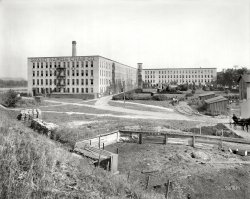
- Toxaway Lodge: 1902
- Sapphire, North Carolina, circa 1902. "The Lodge on Mount Toxaway." Glass negative by William ... an isolated peak) of any mountain point of vantage in North Carolina, probably in the Alleghany chain. The magnificent character of ... Posted by Dave - 08/13/2012 - 9:13pm -
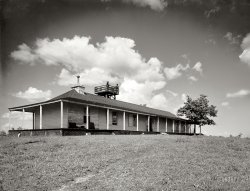
- Daddy: 1939
- ... Whitfield, tobacco sharecropper, with baby on front porch. North Carolina, Person County, near Gordonton." Happy Father's Day from Shorpy! Photo ... Posted by Dave - 06/15/2014 - 7:07am -
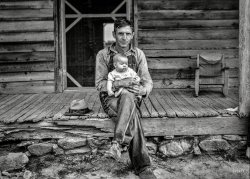
- That's All, Folks: 1936
- ... Grant in storehouse on his farm at Penderlea Homesteads, North Carolina." Medium format negative by Arthur Rothstein. View full size.
... Posted by Dave - 06/29/2017 - 7:41pm -
![That's All, Folks: 1936 December 1936. "C.D. Grant in storehouse on his farm at Penderlea Homesteads, North Carolina." Medium format negative by Arthur Rothstein. View full size.
LOLBest SHORPY caption yet!
Wicked comment!Did tterrace come up with that?
[tterrace didn't even get it at first. What a maroon. -tterrace]
Pork is good foodAnyone who is a carnivore and is not forbidden from consuming pork by his religion can always find a pork product that they love. In the olden days, when people did slaughter and store their own food, neighbors, friends and relatives would share their butchered pig and use almost every bit of it. Did'ja ever hear of "jellied pigs feet?" Mom would simmer the immaculately cleaned feet for hours until they fell apart in the rich, porky broth with seasonings and spices, then after cooling it somewhat would strain the broth and take all the bones out of the boiled meat. She would cut this (feet meat) into bite-size pieces and pour both the strained broth and meat into bowls or molds and refrigerate it all overnight. The broth would congeal into a very sturdy gelatin full of pork, she would slice it up, and the older Polish people would go nuts wolfing it down topped with a bit of vinegar and eaten with good rye bread. Apparently it was something they ate in Europe when times were tough but they sure did love it. It was like a deli treat to them and made the elders very happy and nostalgic and they were literally in hog heaven. (It was probably similar to headcheese but from the feet instead). And no, I did not partake, but who doesn't love bacon, barbecued ribs and succulent pork roast.
Ham and peachesI love the look on this man's face. It says" I work hard to feed my family". Pigs will become ham, pork chops, bacon...on the shelf there are jars of preserved peaches. Biscuits will be made with the fat from the pigs and the sack of flour on the floor.
A winters tailAnd those two hogs would have to last through the winter and then some.
Some perishables for quick consumption (German home slaughtering tradition has the "butcher's soup" which took everything that had no other use and was served to the folks actually turning that hog into food), much of the innards, gristle, bits and pieces going into smoked sausages of various description, in modern times some would be turned into canned sausage, then salted meat, ham, bacon, you name it.
Pickled pig's feetHead cheese, cracklin' boar bristles for brushes. Is true the old saying "Used everything but the oink" on the hog. How well I remember my mother making pickled pigs' feet in the winter. Once you got past the hooves it was just pork.
And this little piggyNow we know what happened to the little piggy that stayed home.
Pig bladder balloonsI enjoy the comments about all that was made from pigs! One my grandfather told me about, was taking the pig's gall bladder (although I suspect it may have been the urinary bladder), and blowing it up into a balloon, tying it with string. It must have been fun to play with, because it was among his favorite childhood memories!
YumI grew up with them and I'm of French-Canadian decent.
(The Gallery, Arthur Rothstein)](https://www.shorpy.com/files/images/SHORPY-8b13882a.thumbnail.jpg)
- Play Ball: 1912
- ... of the boys working in the Saxon Mill. Spartanburg, South Carolina." Photo by Lewis Wickes Hine. View full size.
Textile Mill Baseball As textile mills moved to the South (primarily North and South Carolina) after the Civil War, nearly every mill had a baseball ... Posted by Dave - 09/13/2013 - 11:31am -
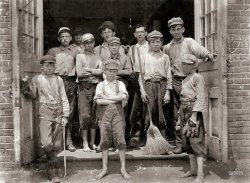
- Everyman: 1940
- ... Mr. U and the rest of the Untitleds somewhere near Durham, North Carolina. 35mm nitrate negative by Jack Delano. View full size.
No ... Posted by Dave - 09/21/2009 - 10:02pm -
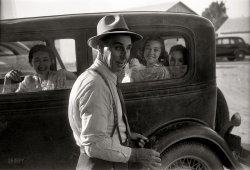
- A Ride on the Boardwalk: 1907
- ... of the hotels in Atlantic City. Being at the ocean end of North Carolina avenue, it commands an unobstructed view of the ocean and the ... Posted by Dave - 08/09/2012 - 2:41pm -
![A Ride on the Boardwalk: 1907 The Jersey Shore circa 1907. "Haddon Hall and Boardwalk, Atlantic City." 8x10 inch dry plate glass negative, Detroit Publishing Company. View full size.
Steamboat Gothic.It may not be on the Mississippi, but Haddon Hall certainly presents all the features of the style.
AmpleLady on the right would be described by my grandmother as a Lady of Ample Bosom. Beautiful photo, thanks.
Capturing life's momentsA great photo to study people of yesteryear. For instance, the handsome couple on the extreme right, strolling along in what appears to be an intense conversation. How cool would it be to recognize, from old family photos, your grandfather and grandmother or even great-grandma and grandpa in their youth? Also interesting in these type photos are the clothes of kids such as the little boy at the end of the ramp with shorts and one of those wide brimmed hats and the teenage girl with ribbons - just as we have seen in old movies. Shorpy is more than a business - it is a great service to understanding past times.
Leeds & Lippincott
Genealogical and Memorial History
of the State of New Jersey, 1910.
In 1890 he [Henry West Leeds] came to Atlantic City and opened Haddon Hall, in partnership with J. Haines Lippincott. Subsequently his mother sold out her interests in the Tremont House and joined with her son in operating Haddon Hall, and winning for it its wide and popular reputation as a homelike hotel. The hotel will accommodate four hundred and fifty guests, and is one of the most central and convenient of the hotels in Atlantic City. Being at the ocean end of North Carolina avenue, it commands an unobstructed view of the ocean and the boardwalk, and during the twenty years that Mr. Leeds has been connected with the house, he has established a most enviable reputation among people of culture and refinement. The house is beautifully furnished and decorated, and on its walls can be seen the best collection of water colors of any seaside resort hotel in the country. The hotel is open all the year.
Stayin' FitI have a strong suspicion that pushing one of those carts about over the course of a season kept one in pretty good shape. I wonder how far these folks usually covered in a day.
(The Gallery, Atlantic City, DPC)](https://www.shorpy.com/files/images/SHORPY_4a18716a.thumbnail.jpg)
- Wheeler's Church: 1939
- ... with brooms and buckets on annual clean up day. Gordonton, North Carolina. View full size.
Wheeler's Church, perhaps? Looking at ... Posted by Dave - 07/30/2012 - 2:39pm -
![Wheeler's Church: 1939 July 1939. Women of the congregation of Wheeler's Church on steps with brooms and buckets on annual clean up day. Gordonton, North Carolina. View full size.
Wheeler's Church, perhaps?Looking at maps of the Gordonton, NC, area, it looks like it should actually be Wheeler's (not Wheeley's) Church. The Wheeler's Primitive Baptist Church Cemetery is at the intersection of Wheeler's Church Road and Union Grove Church Road, and one might assume the church was or is still at that same location. (Yahoo maps link.)
[Could be. But the caption info in the Library of Congress archives says Wheeley's Church. - Dave]
Wheeley / Wheeler's ChurchOriginally Wheeley's Church. Known as Wheeler's after 1830
Separate doors for men and womenI've seen a lot of old churches out in the country with two doors. One old-timer I stopped and yakked with told me that originally men and women sat apart and had separate entrances. I think there's some precedent in Judaism and the early Christian church. Some congregations continued the practice right up to the nineteenth and twentieth centuries. Several churchly web sites suggest this is true, viz. e.g.,
http://www.kemptownumc.org/history_1.html
(The Gallery, Dorothea Lange, Great Depression)](https://www.shorpy.com/files/images/8b34028u1.thumbnail.jpg)
- Let's Eat: 1939
- ... to talk. Wheeley's [Wheeler's?] Church, Person County, North Carolina." View full size. Medium-format nitrate negative by Dorothea Lange ... Posted by Dave - 09/09/2011 - 11:35am -
![Let's Eat: 1939 July 1939. "Congregation gathers after services to talk. Wheeley's [Wheeler's?] Church, Person County, North Carolina." View full size. Medium-format nitrate negative by Dorothea Lange for the Farm Security Administration.
Older than the USAAmazing, the history one uncovers because of Shorpy.
Searching the internet finds that Wheeler's Church is in the Bushy Fork township of Person County and has one of the two cemeteries in the township. More interestingly (to me) was this article that claims the "Wheeler's Primitive Church" was founded in 1760, before the Revolutionary War.
I wonder if any of the people in Ms. Lange's photo are related to Mr. Phelps.
Short skirtsSomething I've noticed looking at historical fashion sites that often seems to be overlooked---throughout much of history--and even to some degree, perhaps regionally, up to my own childhood in the 1970s, it actually was quite normal for girls under 12 or so to wear skirts quite a bit shorter than was usually acceptable for adult women and teens. You'll see Victorian pictures where the little girls have their dresses showing their calves, while their older sisters never would, and certainly no one ever thought twice about a 7-year old in the shortest of short-shorts and a skimpy tube top when I was one. I've two theories why this could be so, and perhaps it's some of both. One is that, while pedophilia has been a problem since time began, it wasn't really thought about in everyday life much, so no one thought much more of showing a little girl's legs than of showing a baby in only a diaper. The other is simple economics( probably especially applicable in the 30s!) It's expensive and hard work keeping skirt-length growing apace with children of that age, and moreover they might not have outgrown the puddle-splashing urge and would likely ruin long skirts much more quickly.
KatieI'm surprised at the length of that skirt on the girl in the doorway. It's significantly above her knees - something that just wasn't done in church, let alone on a girl that age.
[And yet evidently it was. - Dave]
Where are the women and the boys?This could be rural Oklahoma in the late 50's, where the women and girls would be laying out a communal (potluck) Sunday dinner on picnic tables under the trees behind or to the side of the church (and possibly next to the cemetery), and the boys would be spread out across the property letting out their pent up energy after sitting through a (minimum) two-hour service. The young girls in the doorway are "tending" the men, they are there to relay messages from the men to the women and return with answers or the requested individual or item. They also function as *sentinels* for the women, in case a fight breaks out between some boys or a loud argument amongst the men.
Thank you for posting this. I had forgotten how much I love Dorothea Lange!
Getting tangled.As a lady-person, I can attest that sometimes a skirt seems shorter than it actually is--especially if the skirt is slightly pulled up by her efforts to hold the baby. Likely the girls skirt is somewhat longer (you'll notice the uneven-ness) and probably just stuck under baby and blanket.
Anyway==Great photo!
(The Gallery, Dorothea Lange, Rural America, Small Towns)](https://www.shorpy.com/files/images/8b34224u_0.thumbnail.jpg)
- Rockers: 1922
- ... be. This reminds me of my grandmother's house in North Carolina. Oh how I miss those summer days. We stayed outdoors most of the time ... Posted by Dave - 05/19/2008 - 7:50pm -
![Rockers: 1922 Vienna, Virginia, circa 1922. Summer residence of Iowa senator William S. Kenyon and family. View full size. National Photo Company glass negative.
Lovely and TranquilNow this picture conjures the phrase "the good old days".
Looks like nice place to be. This reminds me of my grandmother's house in North Carolina. Oh how I miss those summer days. We stayed outdoors most of the time and made up games to play. Grandma had to call us to get us to come in for lunch or supper. We often had toys that were just tobacco sticks or something else we found on the farm. Looking back we were pretty creative in making up our games with whatever we had at hand. Good memories.
Halcyon DaysThat's certainly a much more modest dwelling than the homes of most of today's politicians.
Up on the roofI noticed the wire going down the left side of the house and wondered if those are those lighting rods or radio antennas on the roof?
[Lightning rods. - Dave]
Vienna VAThat house may still exist. There are a couple in old town Vienna that look a lot like it.
My parents' senatorI grew up in the town that Senator Kenyon usually lived in (he's now buried there) -- Business US 20 on the west side of Fort Dodge, Iowa is named Kenyon Road for him. He was pushed at Coolidge as a vice-presidential nominee in 1924, but he went with Charles G. Dawes instead. This is the first I've heard that he had a summer home out of the state of Iowa. Probably didn't endear him much to the folks back home.
(The Gallery, Cars, Trucks, Buses, Natl Photo)](https://www.shorpy.com/files/images/22077u.thumbnail.jpg)
- Jr. O.U.A.M.: 1938
- April 1938. "Lodge hall in Guilford County, North Carolina." The Jr. O.U.A.M., or Order of United American Mechanics. Which, by ... Posted by Dave - 11/08/2012 - 11:48am -
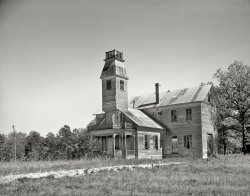
- Not a Cloud in the Sky: 1942
- May 1942. Parris Island, South Carolina. "Marine lieutenant glider pilot in training at Page Field." A smilier ...
The picture is probably an SNJ (Navy/Marines version of North American AT-6). Here's a whole string of photos from that time and place ... Posted by Dave - 06/13/2008 - 8:19pm -
![Not a Cloud in the Sky: 1942 May 1942. Parris Island, South Carolina. "Marine lieutenant glider pilot in training at Page Field." A smilier version of the airman seen here. 35mm Kodachrome transparency by Alfred Palmer, Office of War Information. View full size.
AircraftNo way the aircraft is a "glider." It looks to me like a BT-13 "Valiant" basic trainer, designated an SNV in the Navy and USMC.
[It's a tow plane that pulls the training gliders. - Dave]
An obscure chapter of Parris Island historyThe BT-13 has a triangular window aft of the rear canopy; this one doesn't. Compare to this BT-13 http://ww2db.com/image.php?image_id=3768
The picture is probably an SNJ (Navy/Marines version of North American AT-6). Here's a whole string of photos from that time and place including the same guy http://www.flickr.com/photos/library_of_congress/2179093655/in/set-72157...
The Marine Corps Glider Group 71 was an unusual experiment for the Marines. After watching the Germans take Holland in 1940 with gliders, the Marines thought some catching up was in order, so they set up a glider training group at Parris Island in 1942. After a year, it was shut down when they realized it would not be effective in the Pacific theatre against the Japanese. Today Page Field is thick with vegetation and no longer has aircraft, but is used as a training ground for Marine recruits. Each Marine must pass a greuling multi-day combat trial at Page Field known as "The Crucible" in order to become a US Marine.
(The Gallery, Alfred Palmer, Aviation, WW2)](https://www.shorpy.com/files/images/1a35149u.thumbnail.jpg)
- Five Points: 1940
- October 1940. "Durham, North Carolina. Five Points, center of city, with Chesterfield cigarette factories in ... Posted by Dave - 08/06/2019 - 4:06pm -
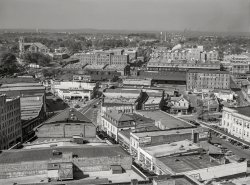
- Harlem Barber Shop: 1939
- ... "Barbershop on Hillsboro Street. Oxford, Granville County, North Carolina." Acetate negative by Marion Post Wolcott. View full size.
A ... Posted by Dave - 04/21/2019 - 8:44pm -
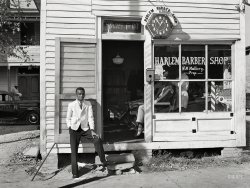
- A Learning Experience: 1957
- ... there were no black kids were in my schools in Georgia or North Carolina because no black families lived in my neighborhood, whereas, overseas, ... Posted by Dave - 03/15/2020 - 3:13pm -
![A Learning Experience: 1957 September 10, 1957. "Integrated classroom at Anacostia High School, Washington, D.C." 35mm acetate negative by Warren K. Leffler for U.S. News & World Report. View full size.
Intergated?Where are they boys?
[In Remedial Spelling. - Dave]
IntegratedThe high school I attended was integrated in 1955, the year I was a freshman, and we never had any problems of any sort. I guess we didn't know we should have.
Based on available evidence and probabilitiesIt's a girls' health class and they're singing a girls' health song.
Vocalizing?They’re all either speaking or singing in unison.
They look older than their yearsThey're teenagers, but appear to me to have an average age of about 35. A couple could pass for grandmothers. I suppose it's due to their hairstyles, eyeglasses, and dresses.
The sad old daysI went to segregated elementary schools in the South as an Army brat, and then would go to integrated schools when we were stationed overseas. As a kid who paid no attention to politics, I just figured there were no black kids were in my schools in Georgia or North Carolina because no black families lived in my neighborhood, whereas, overseas, we had black families living in the same stairwell, so of course those kids went to the same school with me and were our friends.
Class of '55My Dad, Calvin Frye, graduated from Anacostia High School in 1955. He grew up in DC.
(D.C., Education, Schools, News Photo Archive)](https://www.shorpy.com/files/images/SHORPY-03095u.thumbnail.jpg)
- Secret Squirrel: 1922
- ...
Brevard, N.C. = Home of the White Squirrel Brevard, North Carolina, claims to be the home of the white squirrel. They hold their White ... Posted by Dave - 09/08/2011 - 12:12am -
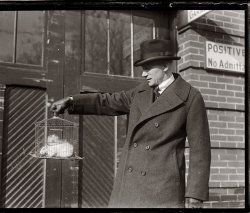
- Wright House: 1936
- ... "Peggy Wright House, Louisburg vicinity, Franklin County, North Carolina. Structure dates to 1796." A house whose paint and charm are inversely ... Posted by Dave - 01/19/2014 - 12:29pm -
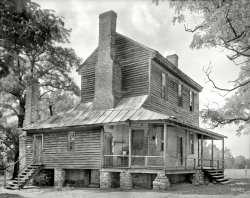
- Newton Cotton Mills: 1908
- December 21, 1908. Newton, North Carolina. "More youngsters in Newton Cotton Mills. Out of 150 employees there ... Posted by Dave - 08/15/2012 - 10:02am -
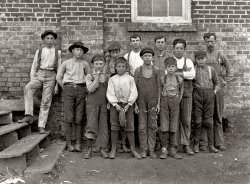
- The Music Man: 1940
- ... West Virginia; Bristol, Tennessee; or High Point, North Carolina. They are carpenters, carpenters' assistants, riggers and laborers. ... Posted by Dave - 10/28/2011 - 2:31pm -
![The Music Man: 1940 December 1940. Radford, Virginia. "Mrs. Jones's boardinghouse. Six men live in this room. Three beds, pay 8 to 10 dollars a week rent. Most have families they left behind in Bluefield, West Virginia; Bristol, Tennessee; or High Point, North Carolina. They are carpenters, carpenters' assistants, riggers and laborers. They make 60 cents to $1.25 per hour." Photo by John Vachon. View full size.
So much for cheap rentA glimpse inside the often-written-about but seldom-seen boardinghouse.
Ten dollars a week to share a bed with another dude, and a room with four more? That's $153.75 in 2010 dollars, or $667 monthly. I think I could still rent a one-bedroom apartment for that in Austin, although just barely. Sure, I'd have to pay my own utilities, but I'd have privacy and much greater comfort.
And why the $8 to $10 range? Sharing a bed with a stranger should be a lowball commodity, I think!
[Boardinghouse rent includes not just the room but also, as the name implies, board. So a comparison would need to include food. - Dave]
You know, I thought of that after I posted it. And just now, I realized I am grateful to John Vachon for using off-camera flash. It further emphasizes the small dimensions of the room!
[He used floodlights. - Dave]
Clark Gable calledHe'd like his ears back.
Six Guys Three BedsImagine the reality TV show this would make today.
Real peopleI love the humanity of this picture - the men are slightly self-conscious, but obviously have made the photographer welcome - I wonder if any of their families knew of this moment in their otherwise forgotten lives.
His mother taught him wellThat guy lying on the bed. Get off the bed with your shoes on! He put his feet on his jacket, not getting his covers dirty.
I've stayed in towns in Iowa at boarding houses and rooming houses in the early 1970s.
(The Gallery, John Vachon)](https://www.shorpy.com/files/images/SHORPY_8c18461u.thumbnail.jpg)
- Young Rush: 1908
- ... Rush Franklin Merrill
Birth
21 Mar 1896
North Carolina
Death
19 May 1982
Gastonia, Gaston, North Carolina, ... Posted by Dave - 04/02/2016 - 8:48pm -

- Guarantee Trust: 1908
- ... turret, on the northeast corner of Atlantic Avenue and S. North Carolina Avenue.
View Larger Map
Guarantee Deja Vu ... Posted by Dave - 03/07/2014 - 3:51pm -
